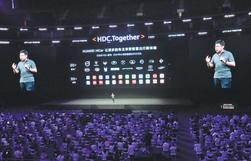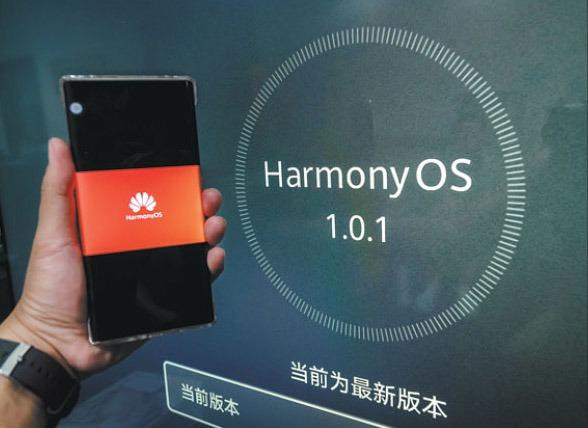 Yu Chengdong, executive director of Huawei and CEO of the company's consumer business group, delivers a keynote speech at the Huawei Developer in Dongguan, Guangdong province, Sept 10, 2020. (PHOTOS PROVIDED TO CHINA DAILY)
Yu Chengdong, executive director of Huawei and CEO of the company's consumer business group, delivers a keynote speech at the Huawei Developer in Dongguan, Guangdong province, Sept 10, 2020. (PHOTOS PROVIDED TO CHINA DAILY)
With technological progress, building a fully connected and intelligent world seems no longer a vision from afar.
A series of technological innovations launched at the Huawei Developer Conference, also known as HDC Together, last week brought the vision into reality.
This year's annual gathering was held at the telecommunication company's Songshan Lake research and development center in Dongguan, South China's Guangdong province, between Sept 10-12.
Software architecture must be adaptive. The more easily it can adapt to changes, the better it proves.
Wang Chenglu, president of Huawei's software department, consumer business group
The audience was briefed on innovative tech solutions, including HarmonyOS 2.0 The upgraded version of the HarmonyOS distributed operating system was debuted last year.
New technologies are conducive to data flow among electronic devices or screens in different sizes, enabling high-speed wireless and seamless connectivity, Yu Chengdong, executive director of Huawei and CEO of the company's consumer business group, said at the meeting on Thursday.
"Huawei has made breakthroughs in the industrial ecosystem, which is dependent on support from developers and partners from around the world," Yu said.
At the HDC Together 2020, Yu said Huawei would open its core technologies, as well as hardware and software resources. Together with developers, it will drive the booming growth in the intelligent industrial ecosystem.
 A staff member shows Huawei Vision smart TV equipped with HarmonyOS operating system during the Huawei Developer Conference in Dongguan, Guangdong province, Sept 10, 2020. (PHOTOS PROVIDED TO CHINA DAILY)
A staff member shows Huawei Vision smart TV equipped with HarmonyOS operating system during the Huawei Developer Conference in Dongguan, Guangdong province, Sept 10, 2020. (PHOTOS PROVIDED TO CHINA DAILY)
The HarmonyOS 2.0 system would create a milestone in the industry, Wang Chenglu, president of software department, consumer business group at Huawei, told the audience.
It will enable high-speed connection, fast identification and sharing resources among various intelligent devices, according to the company.
ALSO READ: Huawei to use own operating system in its smartphones
Wang told media after his speech on stage that HarmonyOS is a system where software can be decoupled, whether horizontally or vertically. That is the reason why a set of codes developed by Huawei can meet the demands from a variety of systems.
"For the software industry, decoupling is the hardest, because it is closely related to architecture," he noted. "Software architecture must be adaptive. The more easily it can adapt to changes, the better it proves."
Decoupling does not just mean physical separation - it matters more to separate from the system's business logistic perspective, he said.
A system is composed of more than 10,000 modules, each born with an ID that will determine what hardware the modules can be used for. After disassembly, the separated units can automatically be restructured into new modules, based on their IDs, according to Wang.
If HarmonyOS had eyes, what it saw would not be separate electronic devices, but different module sets, which can be adaptive to hardware resources and apps needed, he said.
"Personally, I have complete faith in the operating system," Wang said.
HarmonyOS has "enormous potential", he noted, adding that if its ecosystem can be well constructed, it will reshape the mobile industry landscape over the coming two decades.
"While currently, the internet of things might sound abstract to the ordinary, I'm sure there will be a physical world that is identical to a digital one," Wang said. "Once IoT devices and equipment are connected, they will form the digital world's sense systems."
Without full, multidimensional information collected, a city brain cannot make accurate judgments nor work properly, Wang said.
Intelligent management is the key to increasing efficiency in a city's transport and logistics and IoT technology is expected to change a city's structure, he noted.
Yu announced at the conference that HarmonyOS will be open to developers, offering them with emulators and software development kits as well as integrated development environment tools.
Huawei would donate related codes to the OpenAtom Foundation, a nonprofit organization dedicated to promoting open source software, he added.
The first to go on the road map for the open source HarmonyOS are IoT equipment and devices, ranging from 128 kilobytes to 128 megabytes in memory size. Their codes have been open since Sept 10, according to Yu.
ALSO READ: Experts optimistic Huawei can face storm
Devices with a memory size ranging from 128 MB to 4 gigabytes will be the second, with their codes scheduled to open from April 2021.
Starting from October 2021, codes for all devices starting at 4 GB of memory will be open, Yu said.
The HarmonyOS developer beta version, designed for smartphones, is slated to be released in China at the end of 2020, he said.
Yang Haisong is vice-president of the software department at Huawei's consumer business group. He said the company aims to have more than 200 million devices and equipment powered annually by HarmonyOS, with half of them from Huawei's own brands and the other half from third-party businesses.
Huawei announced at the meeting that it has partnered with home appliance manufacturers Midea, Joyoung and Robam Appliances to equip some of their product portfolios with HarmonyOS.
READ MORE: Huawei founder sees 'live or die moment' from US uncertainty
In addition, with major upgrades in connectivity, interaction, operation, certification and solutions, HiLink provides easy access to different smart home appliances and electronics, according to Huawei.
Data from the company show that the network has 50 million users and received an average of 1 billion daily requests for intelligent operations.


